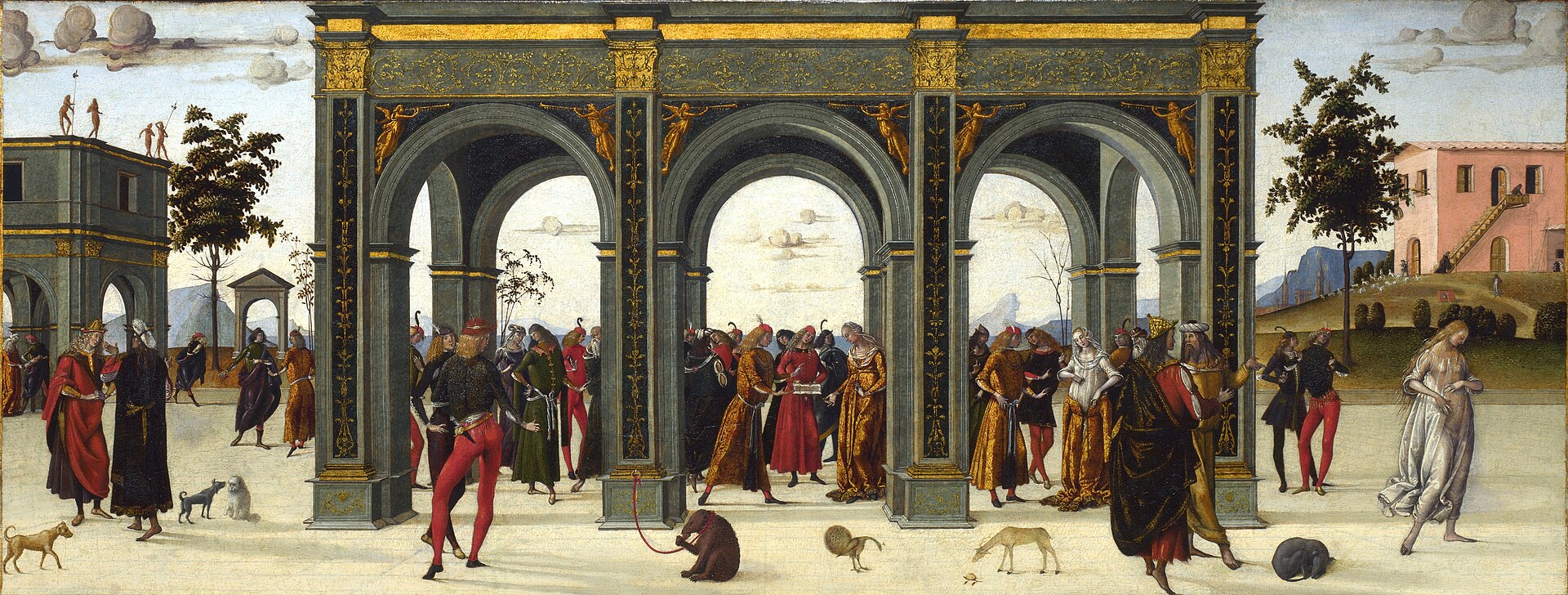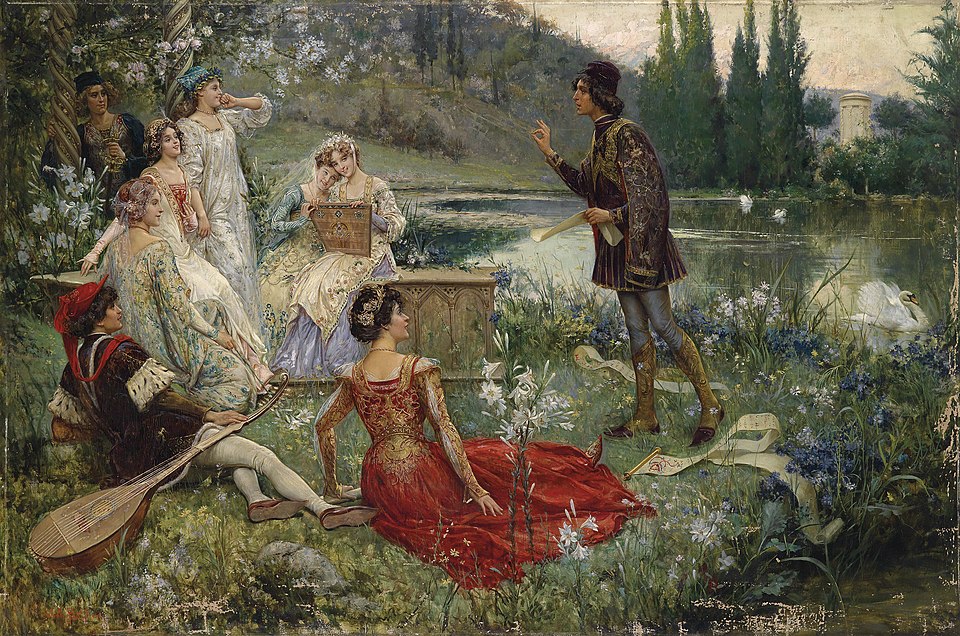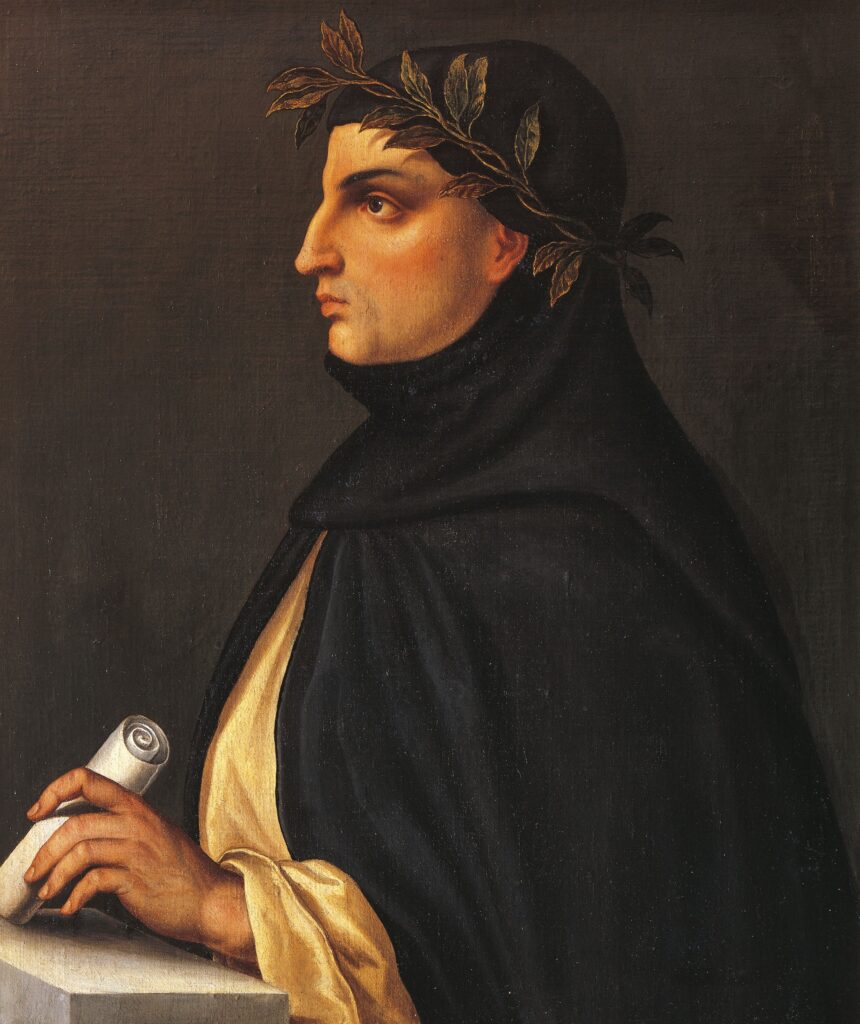By Cala Annala
Boccaccio’s late-medieval masterpiece, The Decameron, presents one hundred stories that seem to reflect contradictory moral messages. The text, composed of ten stories told daily by ten narrators over ten days, includes tales depicting their characters engaging in depraved actions seemingly without consequences, while other stories present a clear moral message. This apparent contradiction prompts one to question whether the author is promoting an amoral approach to life in which morality is utterly subjective or is satirizing this approach with serious moral intent. This question may be answered through a close examination of the following: the framing of the setting in which the stories are told, the phrasing the author uses in both types of tales, and an analysis of the statements of intent in the text’s preface and conclusion. Such an analysis reveals that although Boccaccio’s satirical tales do seem to endorse a type of subjective morality, when examined closely, they reveal moral allegories that place them squarely within an ethical framework. Further, his emphasis on social order within the setting of the book can be interpreted as a testament to the importance of retaining a moral framework. As a result, one may conclude that although The Decameron is not intended to be a didactic work, it nonetheless retains a moral framework while satirizing the amoral lifestyle for entertainment.
How the text’s introduction frames the stories by describing the time, place, and circumstances of characters telling and listening to them suggests that it is not Boccaccio’s intent to promote an amoral lifestyle. The Decameron takes place in medieval Florence in 1348, the time of the Black Death, and centres around seven young ladies and three young men who decide to leave Florence and the chaos caused by the plague, escaping to a villa in the hills of Fiesole (6-7). The author emphasizes at length the calamitous and sordid state of Florence during the Black Death, stating that “the city was full of corpses,” and “people who died were cared for as we care for goats today” (12, 13). In particular, he underscores the breakdown of social order within the city at this time, where “out of sheer necessity, there arose among those who remained alive customs which were contrary to the established practices of the time,” such as “one citizen [avoiding] another” and “almost no one [caring] for his neighbor” (10-11). In travelling to the Fiesole countryside, the characters in this story are seeking respite from the chaos of Florence and attempting to rebuild a social structure within their small group. This interpretation is further evidenced by the group appointing a leader (a queen or a king) each day to rule them, stating that “when things lack order they cannot long endure” (21). Therefore, the fact that the characters seek to escape the breakdown of morals in Florence and create for themselves some semblance of a structured society suggests that the author is concerned with social order and morality, and his motive is not to promote a lifestyle lacking these vital components.

In analyzing the stories within this frame narrative, the first story on the first day provides an excellent example of a tale that appears to promote amorality through its exaggerated portrayal of unscrupulous behaviour, but upon closer inspection, presents this behaviour only for entertainment purposes to shock and thrill readers while quietly condemning it. For example, one of the stories revolves around Ser Cepparello, a notary who committed nearly every imaginable evil during his lifetime, including legal fraud, giving false testimony and false oaths, stirring up scandal, sowing discord, murdering, thieving, blaspheming God and the Church, and being “the most irascible man alive” (27). At the end of his life, Ser Cepparello remains unrepentant of his sins, yet succeeds in deceiving a priest into believing that he is “a holy man” deserving of “the greatest reverence and devotion” from the Church, and is venerated as a saint after his death (36-37). While it appears that Boccaccio is promoting an amoral lifestyle since Ser Cepparello’s amorality seems to be rewarded in this story, the author makes the following key statement towards the end of this story:
“[Ser Cepparello] may have been blessed in the presence of God, since although his life was evil and sinful, he could have become so truly sorry at his last breath that God might well have had pity on him and received him into His kingdom . . . but . . . I believe that he is, instead, in the hands of the Devil in Hell rather than in Paradise” (37).
This passage indicates that while the author and reader cannot rule out the possibility that Ser Cepparello might be in heaven, it is far more likely that he is “in the hands of the devil” instead (i.e., hell). Thus, Boccaccio portrays the significant negative consequences of an amoral life here, making it clear to the careful reader that he is not advocating such a lifestyle.
Likewise, the first story on the third day also portrays a character engaging in exceptionally amoral actions while subtly indicating this lifestyle’s true consequences and undesirability. This story centres around a character named Masetto da Lamporecchio who pretends to be a dumb mute to gain a position as a gardener at an abbey, where the nuns compete to lie with him. Boccaccio brazenly states that Masetto’s “labours were shared in such a way that he was able to perform them. In performing them, he generated a large number of little monks and nuns” (200). This scandalous behaviour seems to be rewarded in this tale, with Masetto “easily” returning home with “the money he had made” at the end of the story (200). However, Boccaccio highlights the true undesirable consequences of Masetto’s behaviour in the final lines of the story, which state that “Masetto returned home old and rich and a father, without ever having to bear the expense of bringing up his children” (200). When The Decameron was written, being a father was an honourable role and raising one’s children was an esteemed duty. Having left all his children with the nuns in the convent, Masetto deprives himself of this esteem and is left with no one to carry his name and no legacy on earth. The ultimate undesirable consequences of the nuns’ transgression of their vows are also highlighted by the author in the final lines of the story, which imply that the nuns will have to bear the consequences and shame of raising these “little monks and nuns” alone (200). Thus, at the end of this story, he makes it clear to the reader that both the nuns and Masetto will face the unpleasant and dishonourable consequences of their actions.
The moral thread within the satirical amoral content of these stories is reinforced through the last story of The Decameron, the tenth story on the tenth day, which focuses on depicting the moral theme of reward that results from enduring hardship righteously. This story centres around a man named Gualtieri, the Marquis of Sanluzzo, who marries an extremely poor woman named Griselda. The exceedingly virtuous Griselda was an ideal wife for Gualtieri, being “pleasing, attractive, and well mannered… obedient and indulgent… [and] so gracious and kind to her husband’s subjects that there was no one more beloved or gladly honoured than she was” (790). Despite this fact, “a new thought entered [Gualtieri’s] mind: he wished to test her patience with a long trial and intolerable proofs,” and thus began inflicting great hardships upon Griselda (791). Over several years, he imposes increasingly harsh trials to test the quality of her character. He subsequently “[offends] her with harsh words,” orders a servant to send her daughter and son away under the guise of having them murdered, pretends to obtain a divorce order and sends her destitute back to her father’s house, and finally calls her back to his own home under the pretense of having her plan the wedding for him and a new wife—the last of these being like “a dagger in Griselda’s heart” (791-795).

After Griselda undergoes all these trials while retaining her humility, obedience, and patience, “suffering with brave spirit the savage assaults of a hostile Fortune,” Gualtieri then takes her again as his wife, reunites her with their children, and they live “a long and happy life” together (798). To the average reader of this tale during Boccaccio’s time, this storyline would have been highly reminiscent of the depiction of the life of Job within the Bible, who, like Griselda, was rewarded greatly at the end of his lifetime because he remained humble and righteous, though he experienced great loss and hardship. Thus, the conclusion of the stories within The Decameron with Griselda’s moral allegory reinforces the principle that, despite their frequently bawdy content, the author incorporates a moral framework within his stories.
Therefore, it is clear that Boccaccio’s purpose in The Decameron is not to promote amorality. If this is so, then why does he portray such instances of amoral behaviour in these stories? The answer to this question may be found in the text’s preface and conclusion, in which he makes it apparent that his purpose in creating this work is to provide women with an amusing form of entertainment that will divert their attention from the dreadful consequences of the plague in their present life, as well as serve as a “support and diversion for those ladies in love” (5). In the conclusion to this work, he states that he is “offering this work of [his] to idle ladies and no others… to those who read it to pass the time of day” (805). Thus, the scandalous behaviour presented in these stories is intended by Boccaccio simply to provide women with entertainment that will divert their attention from the hardships of daily life, and not to promote the literal carrying out of this behaviour. He further states that “these tales… may be harmful or useful depending on who the listener is” (803), indicating that although these stories are not intended to encourage the lascivious behaviour present within them, they nonetheless may be interpreted this way if the reader lacks insight into their true purpose.
In conclusion, while Boccaccio’s Decameron ostensibly appears to be an endorsement of the amoral life, upon closer analysis, it is revealed that he satirizes this life for amusement while also reinforcing moral principles. This reinforcement of moral principles is evidenced by his emphasis on the importance of social order when framing the setting of the work. Further, even within the tales that seemingly portray the desirability of an amoral lifestyle, there are statements toward the end of these stories that shift them back into a moral framework and suggest the true undesirable consequences of the depicted behaviour. Therefore, although Boccaccio’s preface and conclusion indicate that his purpose for this work is to entertain and not to advocate for the morality of the character’s actions, he nonetheless clearly incorporates moral principles into the tales of The Decameron, demonstrating his excellence in tactfully satirizing amorality for entertainment purposes while still preserving a strong moral framework within the stories.

Works Cited
Boccaccio, Giovanni. The Decameron. Translated by Mark Musa and Peter Bondanella, Signet Classics, 2010.
